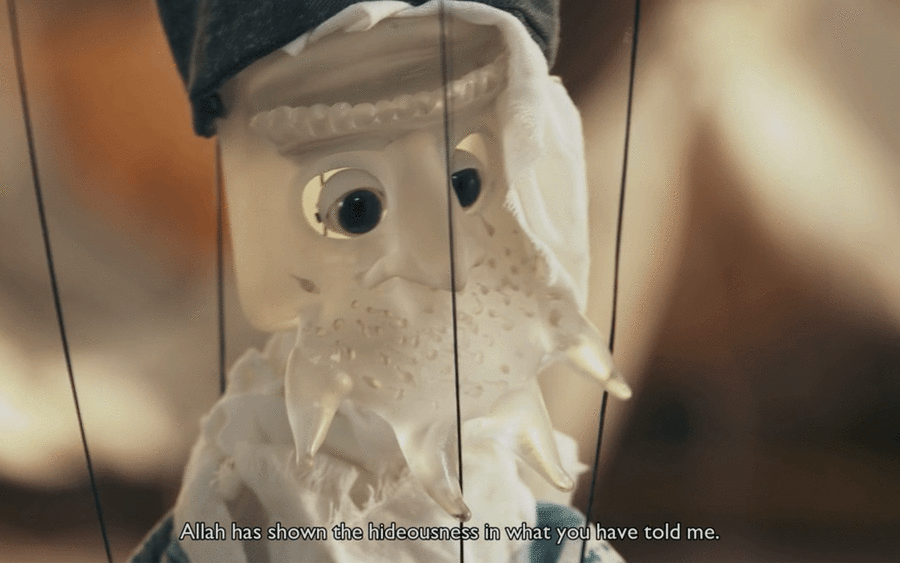When the photographer Peter Hujar trained his lens on the avant-garde denizens of 1970s downtown New York, he didn’t just capture their likenesses – he exposed their souls. His series ‘Portraits in Life and Death’ laid bare the beauty and vulnerability of cultural icons like Susan Sontag, Fran Lebowitz, and John Waters with an uncompromising intimacy. Now, from April 20 to November 24, the full provocative collection will be unveiled during the 60th Venice Biennale in a major exhibition organized by the Peter Hujar Foundation and curated by the Art Institute of Chicago’s Grace Deveney.
The 41 photographs in ‘Portraits in Life and Death’ juxtapose Hujar’s penetrating images of the glitterati with jarring shots of mummified corpses from Palermo’s Capuchin Catacombs. It’s a daring memento mori from an artist who, as Sontag wrote in her introduction to the book, ‘knows that portraits in life are always, also, portraits in death.’
In this insightful interview, Hujar’s longtime friend, the novelist Stephen Koch, offers a window into the tormented mind behind the camera. With remarkable candor, Koch – who now leads the Peter Hujar Archive – reflects on their intense creative kinship, Hujar’s ravenous appetite for success, and the devastating impact of Aids, which claimed his life in 1987 at the age of 53.
Going back to 1965, how did you meet Peter? I heard it had to do with Susan Sontag.
Yes. I was a very young writer in New York and had become a kind of protégé of Susan’s. One day early in the friendship, I had been hanging out with her and she said, ‘Don’t go just yet. There’s someone coming by who you might want to know. He’s a photographer.’
So I stayed, and in came Peter. He was tall and soft-spoken, with a strong but understated presence. He sat in a great big Mission rocker that was in Susan’s living room – but he didn’t rock. Nobody, but nobody, could sit still like Peter. He had come after a day’s work in a commercial studio, which is how he supported himself at that time. It’s important to know that Peter’s entire apprenticeship in photography took place exclusively in large commercial photo studios. He learned everything on the job. He never went to college and never took any kind of academic class in photography.
That day, his job had been to photograph Jayne Mansfield. When he started talking about her, it was like listening to a great novelist talk. He was so observant, he made you see it all. The way she moved, how she handled her body, her clothes, her nakedness. The way her parents and husband sat nearby on folding chairs, watching everything. Her relation to her breasts. I remember him saying, ‘Her nipples were the color of crushed raspberries.’
So, after that first introduction, we ran into one another here and there. We were merely acquaintances, but three or four years later, when I published my first novel [Night Watch, 1970], I needed an author picture. I went to the studio he had by that time, paid him $60, and he made a good, albeit rather posed, dust-jacket portrait of me. And we began inching toward friendship.
Five years after that, in 1975, Peter had the idea for ‘Portraits in Life and Death’, which was the only book he published in his lifetime. He asked to do Susan’s portrait and made the reclining portrait of her that is now world-famous. He also asked her to write the preface to the book. She agreed.
But then she procrastinated. Sometime around when the book was going to press, Susan developed breast cancer. I was very close to her at that time, and I remember going with her son and perhaps two other people when she checked in to Memorial Sloan Kettering hospital, where she was to have her first biopsy. We all stayed late that night. Illness and death were in the air. At one point, when she was already in bed, she said to me, ‘Wait! I forgot something! I promised to write Peter’s introduction! Bring me some paper.’ So I brought her some paper and a magazine on which she could write. She curled up her knees and started writing. In under an hour she wrote the whole essay.
The next morning, while Susan was in surgery – the results of which were very alarming – I typed up the essay and took it over to Peter’s loft. It was the first time I had ever been in his loft. From that point on we developed a stronger and stronger friendship, even though we were virtually opposite personalities. I was from a classic Midwestern upper-middle-class professional family. Peter had been a New York City street urchin. His father was a bootlegger who abandoned his mother when she was pregnant. At first, his mother couldn’t support him, so when he was very young, he was sent to a kind of farm in New Jersey to live with his grandparents. Things degenerated. After the death of his grandmother, others in the house, Peter’s uncles and aunts, began to abuse him. I later figured out that one key to Peter’s personality was that anyone who had been an abused child was automatically on his A-list. Of course, by far the most important, and most seriously abused of those children, was David Wojnarowicz, who became a kind of spiritual son to Peter.
Anyway, after 1976, Peter and I developed a pattern – he would come to my house for dinner once a week. We gossiped, talked about work, art, whatever. After dinner we would sit listening to music – Mozart, Brahms, or Patsy Cline were typical – I with a glass of wine, which he didn’t like seeing me drink, and he with a glass of wine that he barely touched. Peter was very uncomfortable around alcohol because alcoholics had raised and abused him.
But one not-so-gratifying part of our weekly chats was news about Peter’s business life –his terrible, hopeless, impoverished business life. Peter greatly desired ‘success.’ He was mesmerized by it, but he froze up and created one irrational obstacle after another to doing whatever was necessary to make an artistic career work. It was a mysterious contradiction – Peter rejected ‘success’ as much as he craved it. As Fran Lebowitz said at his funeral, ‘Peter Hujar has hung up on every important photography dealer in the Western world.’
His poverty appalled me. Here was a guy who paid something like $170 a month for his loft, and he was quite often strapped for it. I could not believe that someone of his extraordinary intelligence, talent, and achievement couldn’t put together a few hundred dollars a month to live on. It troubled me. Baffled me. Annoyed me. I would say, ‘Peter, it is not just deplorable that you can’t pay your rent. It is ridiculous. If I had another life, I know I could make you successful.’
Did he want financial success?
No. Money wasn’t his heart’s desire, and for that matter neither was mere celebrity. He craved something more. He wanted glory, fame that would be like magic, able to transform you into…God knows what – an icon, a cultural dream.
Let me give you an example. When we were in the process of getting his Aids diagnosis, it was obvious the news was going to get worse. One day, after a very discouraging visit to the hospital, Fran Lebowitz confronted the grim news with a typical Fran solution. ‘Peter,’ she said, ‘let me take you to lunch.’ Shallow? Not a bit. It was a great act of kindness because Fran shrewdly took us to a place where she knew the real stars ate lunch. When we were seated, we spotted at a nearby table none other than Dolly Parton, complete with her entourage. Now, Peter’s life was in grave danger. The news was bad. But he beamed. He was sitting beside Dolly Parton! The man was dying, but it was pure bliss.
Did you ever discuss sex?
He didn’t much talk about the details of his personal life with me, and I didn’t ask. I knew he was chronically lonely, and I was always delighted on the rare occasions that a real relationship seemed to be budding. But in a way, my role was to be his bourgeois brother, and there are certain things you don’t discuss with your bourgeois brother. It was only after he died that I grasped how compulsively promiscuous he had been.
Yet I hasten to add that Peter was almost uniquely serene and open about being gay. He wasn’t aggressive about it. He didn’t preach or overstate his identity, but nothing about being gay made him ashamed, or secretive, or uptight. This was very unusual. Especially in those days, most gay people went through some sort of personal or social trauma learning to cope with their otherness, and they had scars that showed. Peter didn’t. He may have been lonely and unhappy and poor, but he was unconflicted about his sexual identity, both in his life and his art. It is hard to overstate how rare that was 40 years ago.
But then came Aids.
Then came Aids. My wife is a doctor. In December 1987 Peter came over for dinner. He told us that something was wrong because he just couldn’t get out of bed. He was sleeping 16 hours a day. He said, ‘I’m sure it’s because I’ve stopped smoking.’ Now, Peter had ‘stopped smoking’ a billion times. My wife knew that wasn’t the problem, and before he left, she tested the glands in his neck. She later told me she hoped – hoped against hope – the problem might be depression. Peter was very subject to depression. But she was pretty sure that the real problem was ‘It.’ It was ‘It.’ From that point on, he was dying.
Peter Hujar
‘Portraits in Life and Death’
On view from April 20 to November 24, 2024
Istituto Santa Maria della Pietà
The Estate of Peter Hujar is jointly represented by Pace Gallery (New York City), Fraenkel Gallery (San Francisco), together with Mai 36 Galerie (Zürich) and Maureen Paley (London).
Matthew Leifheit is an American photographer, professor, and the editor-in-chief of MATTE Magazine. His photographs have appeared in publications such as The New York Times, The New Yorker, and Aperture. He is currently on faculty at Pratt Institute and Yale.
The original version of this interview was published in Art F City. It has been substantially reworked and is published with kind permission of the author and interviewee.
Caption for top image: Peter Hujar, Susan Sontag, 1975. © The Peter Hujar Archive/Artists Rights Society (ARS), NY. Courtesy of Peter Hujar Foundation.
Published on April 15, 2024.


